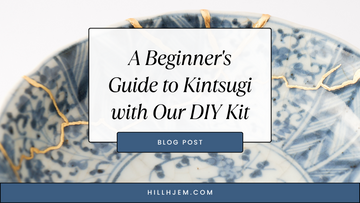
Have you ever cherished a piece of pottery, only to see it suffer a crack or chip? Disposing of it feels wasteful, but leaving it broken feels incomplete. Kintsugi (pronounced "kin-tsoo-gee"), the captivating Japanese art of repairing pottery with gold, offers a stunning solution.
Instead of hiding the cracks, Kintsugi celebrates them, transforming the broken piece into a unique and even more beautiful treasure.
This beginner-friendly guide will walk you through the simple steps of using a Kintsugi DIY kit to breathe new life into a broken piece.
What you'll need:
- Our Kintsugi DIY Kit (including practice dish, golden dust, gloves, instruction manual, wood sticks, and glue)
- Rubbing alcohol (optional)
- Cotton swabs (optional)
- Sandpaper (optional)

Caution: While our kit comes with a practice dish, the following steps involve breaking your chosen piece. Proceed with extreme caution and at your own risk. This process is not recommended for valuable or sentimental pieces.
Let’s get started!
Step 1: Embrace the Break (Carefully!)
Important: Wear safety glasses throughout this process to protect your eyes from potential flying shards.
Here's how to break your chosen piece (with extreme caution):
- Gently wrap the piece in several layers of newspaper or cushioning material to minimize potential damage.
- Choose a carpeted area or place a thick towel on a hard surface to provide some padding.
- Using the back of a spoon or a similar blunt object, carefully apply controlled pressure to the weakest point of the piece. Be extremely cautious and do not use excessive force.
Step 2: Cleaning and Preparation
- Gently wipe down the broken pieces of your practice dish with a damp cloth, removing any dust or debris. You can further clean with rubbing alcohol on a cotton swab for a stronger clean.
- Carefully lay the broken pieces together on a flat surface to ensure a good fit. Make adjustments if necessary for proper alignment.
Step 3: Applying the Adhesive
- Put on both gloves for protection and to prevent fingerprints on the ceramic.
- Apply a small amount of glue to the edge of one broken piece using a wood stick. Be mindful not to use too much, as excess glue can be messy and difficult to remove.
- The glue will dry quickly, so only use as much glue as is needed for the mend.
-
Carefully align the piece with the corresponding edge of another piece and gently press them together. Hold them firmly for a few seconds to allow the adhesive to set.
-
Repeat steps 3.2 and 3.3 for all the broken pieces, working your way around the dish until all the pieces are secured together.
Optional: If you're feeling adventurous, you can skip steps 4.0 and 5.0 by adding the gold dust directly to the wet glue. Mix them together with the wood stick until you achieve the desired color.
Step 4: Embracing the Imperfections
- Unlike traditional methods that strive for a seamless repair, Kintsugi embraces the cracks. Leave a slight gap between the pieces to create a visible line where the gold will be applied later.
- While the glue is still wet, use a cotton swab dipped in rubbing alcohol to gently remove any excess glue that may have oozed out from the joints.
Step 5: The Golden Touch
- Open the pack of golden dust carefully and hold it over a piece of paper to avoid spilling.
- Gently tap the pouch to disperse the gold dust onto the cracks and gaps between the repaired pieces. Use a wood stick or a dry brush to lightly spread and manipulate the dust, ensuring it covers the desired areas.
- Apply multiple light layers of gold dust for a more prominent and even finish. Be patient and allow each layer to dry slightly before applying the next.
Step 6: Final Touches
- Allow the Kintsugi repair to dry completely, following the recommended drying time mentioned in the instruction manual. This can take anywhere from 24 to 48 hours, depending on the thickness of the glue and the number of layers of gold dust applied.
- Once completely dry, you can use fine-grit sandpaper to gently remove any excess gold dust from the surface of the dish.
Congratulations! 🎉
You have successfully revived your practice dish using the art of Kintsugi. Remember, the true beauty of Kintsugi lies not just in the final product, but in the journey itself. It's a process of acceptance, creativity, and finding beauty in the unexpected.
Once comfortable with the process, feel free to use your acquired skills to repair a cherished broken piece. Remember, the more sentimental the piece, the more careful you should be. Take your time, work meticulously, and embrace the history and story etched into the cracks.
A Life Lesson in Kintsugi
The philosophy of Kintsugi extends far beyond the realm of repairing pottery. It serves as a powerful metaphor for life's experiences. Just like the broken pieces of pottery, we too experience life's cracks and imperfections.
Kintsugi reminds us that these experiences, however challenging, shape us into who we are. They can be mended, embraced, and even transformed into something beautiful and unique, adding a touch of golden resilience to our journey.
Ready to give it a try? Our beginner-friendly Repair Kit allows you to experience the joy of Kintsugi right at home. Grab yours now!




